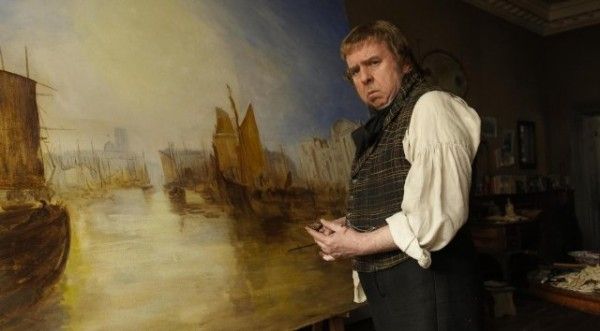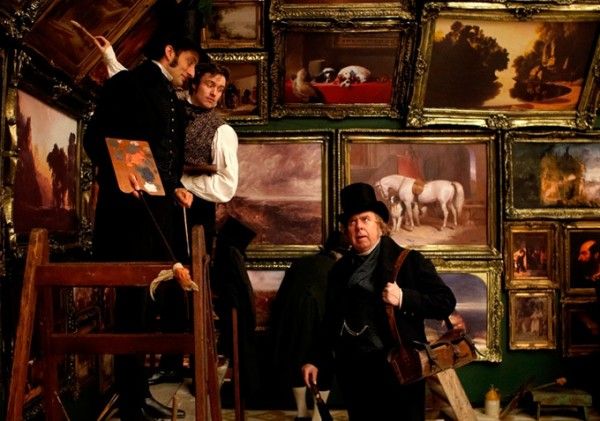Painter J.M.W. Turner, the eponymous subject of Mike Leigh’s new biopic Mr. Turner, was renowned for painting shipwrecks. A lazier film would condense Turner’s life around that simulacrum. Instead, Leigh chooses to look at the whole picture, and not just in showing a three-dimensional protagonist. Turner is part of a painting that includes a fascinating look at early-to-mid 19th century life in Europe. Leigh adds all the wonderful touches of the era’s dialect, vernacular, and linguistics along with a collection of other meticulous details to provide a vivid period piece. And it’s all built around an unforgettable performance from Timothy Spall who coughs, whistles, wheezes, and primarily grunts in his portrayal of an artist who personally and professionally defied easy categorization.
The story follows Turner (Spall) along his professional and personal life, although we begin at the apex of his success. Instead of seeing a young Turner pick of a piece of charcoal and begin to scribble, we meet him in the last quarter-century of his life and witness the complexities of his private and public spheres. We see how the admiration from the public and his peers fade, and the development of his bizarre relationship with his housekeeper Hannah Danby (Dorothy Atkinson) and an oddly sweet romance with landlady Sophia Booth (Marion Bailey).
Leigh does an exquisite job of telling us everything about our protagonist and his world before a single word is even uttered. The picture opens on a picturesque vista with two maids walking towards the camera, happily talking to each other. They are part of a vibrant canvas, and as they walk by, we see Turner, a shadowy figure in the background. He’s hunched, rotund, and doesn’t belong in this scene vista, but we know he’s going to capture it perfectly.
The film is masterful in how strikingly it depicts the time period both in its beauty, simplicity, but it never embellishes. We are transported but we are transported through Turner’s eyes. He sees the world pragmatically and even coldly at times, but he’s also aware of its beauty. Turner is a mess of delightful contradictions. He abandons wife and children to the point of refusing to acknowledge their existence, but he also deeply loves his supportive father, William (Paul Jesson). Turner is awful to Hannah, barely refusing to acknowledge her existence beyond using her for cleaning and sex, but he’s warm and sweet towards Sophia. He’ll paint on a beautiful landscape, but then spits on the canvas to get the color just right.
Leigh revels in these juxtapositions. Gary Yershon’s score is triumphant but in between the notes there’s a mournful, off-key tune. We all know that artists aren’t personally as pretty as their artwork, but Turner’s part of a larger scene. He’s defined not only by his distinct personality, but also by how he fits in with the larger milieu. Even the major events of his life don’t radically transform who he is. There are no “turning points” and time passes unremarked. The director is working on a big canvas, and it’s rewarding to see how the picture develops even if can be difficult to get our bearings in terms of time and context.
At times, this full immersion can work towards the film’s advantage as we become lost in the time period and enraptured in its eccentricities. It was a simpler age when a man could go to a boarding house and converse with strangers about siblings who died from scrofula and regrets of being a slaver. People would even be willing to have a conversation about gooseberries, although I suspect Leigh finds this particular situation intentionally comic as opposed to bizarrely quaint. However, there are also times when the portrait becomes too big and the setting becomes too daunting. When Turner sees a stage show critiquing his work, we have no context about why this show exists, why he was attending it, and if this kind of critical presentation was common.
I suspect art majors and art history majors will get slightly more out of Mr. Turner, but the movie’s power is not exclusive to those who are already familiar with Turner’s work. Some of the most distinctive scenes have little or nothing to do with Turner, and instead are about how he connects to these moments. One of my favorite scenes is where fellow artist Benjamin Robert Haydon (Martin Savage) walks away into the distance. The destitute artist trudges into the distance and becomes smaller and smaller as Turner and his friends bemoan their poor compatriot. The composition of the shot—Haydon in the center in the frame, walking straight into the middle distance as his fellow artists anchor the bottom of the screen—is tremendous in how it perfectly illustrates how artists are defined and redefined by their contemporaries and their descendants.
I don’t know how closely the real Turner resembles the one in the movie, but, for better or worse, he will be defined by Spall’s phlegmatic performance. I believe it’s for the better as Spall deftly wields every grunt to convey a wide variety of emotion, and also provide the humor the movie so desperately needs. It’s a performance that’s easy to parody yet remarkably poignant. Spall carries so much sadness and devilish energy in his eyes that we remember we’re watching a person rather than a jumble of peculiar and sometimes disgusting tics.
Mr. Turner provides enough major beats to follow the artist’s life, but the lack of explanation shows that Leigh is looking at a much bigger picture. He has stepped back from a mere biopic of an eccentric figure painting pictures, and instead tapped into what the act of painting that picture means to history, to culture, and to a person.
Rating: B
Click here for all of our TIFF 2014 coverage. Click on the links below for our other TIFF 2014 reviews:





